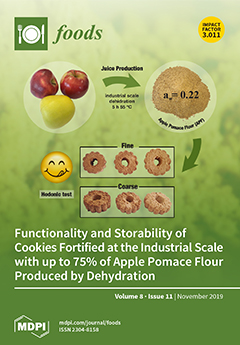Current trends in meat packaging have seen a shift from conventional overwrap to vacuum packing (VAC) and modified atmosphere packaging (MAP). The aim of this experiment was to investigate the effects of high oxygen MAP (HiOxMAP) of pork loins compared with vacuum packed (VAC) on eating quality and colour, after storage in simulated illuminated retail display conditions. Pork loins (
n = 40) were cut and stored under two packaging methods (HiOxMAP, 80% O
2, 20% CO
2; VAC) for up to 14 days, with samples taken at various times for measurements. After 7 days of storage, HiOxMAP samples exhibited inferior consumer acceptability for tenderness, flavor, overall liking, quality and re-purchase intention as well as higher shear force and hardness, relative to VAC samples (
p < 0.05 for all). Loins stored in HiOxMAP had higher lightness (L*), redness (a*) and yellowness (b*) values at 3 and 7 days, but lower ratio of oxymoglobin to metmyoglobin (oxy/met) values in the meat surface at 14 days of display, relative to VAC samples (
p < 0.05 for all). The oxy/met ratio declined from 2.3 to 1.7 between days 3 and 14 of display in HiOxMAP samples (
p < 0.05), whereas the ratio was similar and stayed relatively high for VAC samples. VAC samples produced consistently higher colour values (a*, b*, oxy/met) when left to bloom 30 min after removal from packaging (
p < 0.05). Lipid oxidation values, measured using thiobarbituric acid reactive substances, in HiOxMAP pork loins, were higher at all time points compared to VAC during the 14 day storage period (
p < 0.05). The use of vacuum packing for retail shelves, should be considered as the preferred option, over HiOxMAP.
Full article






